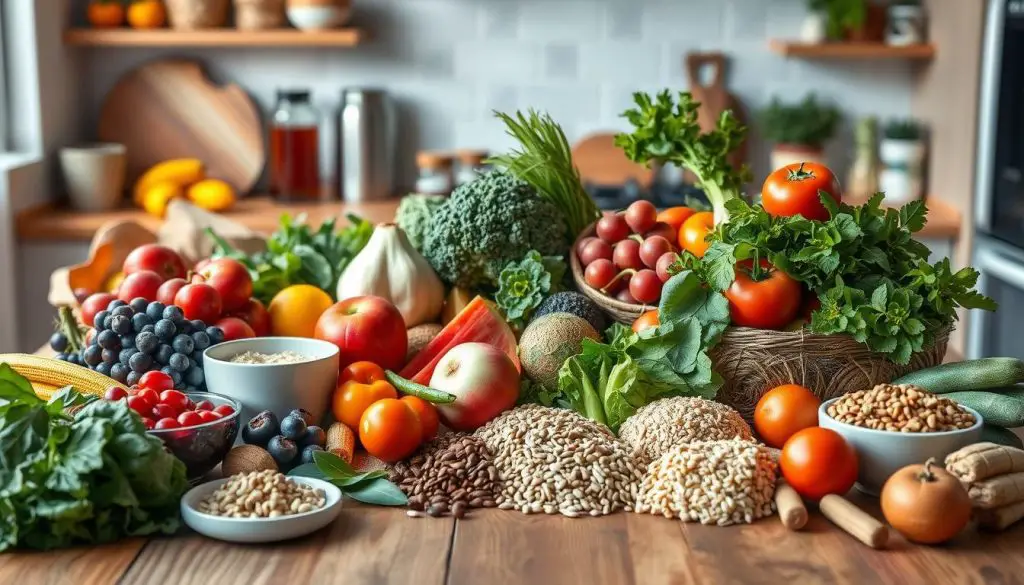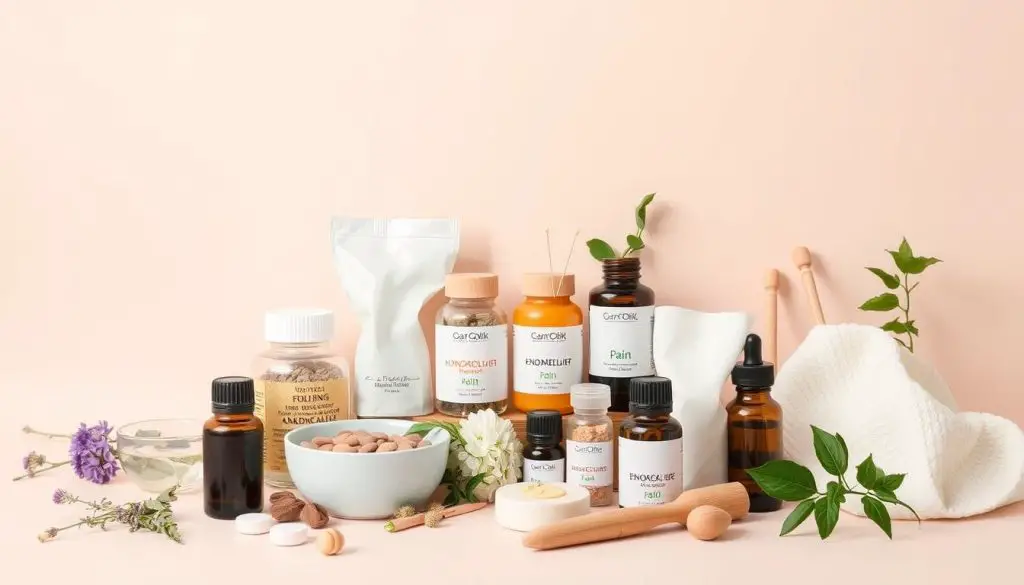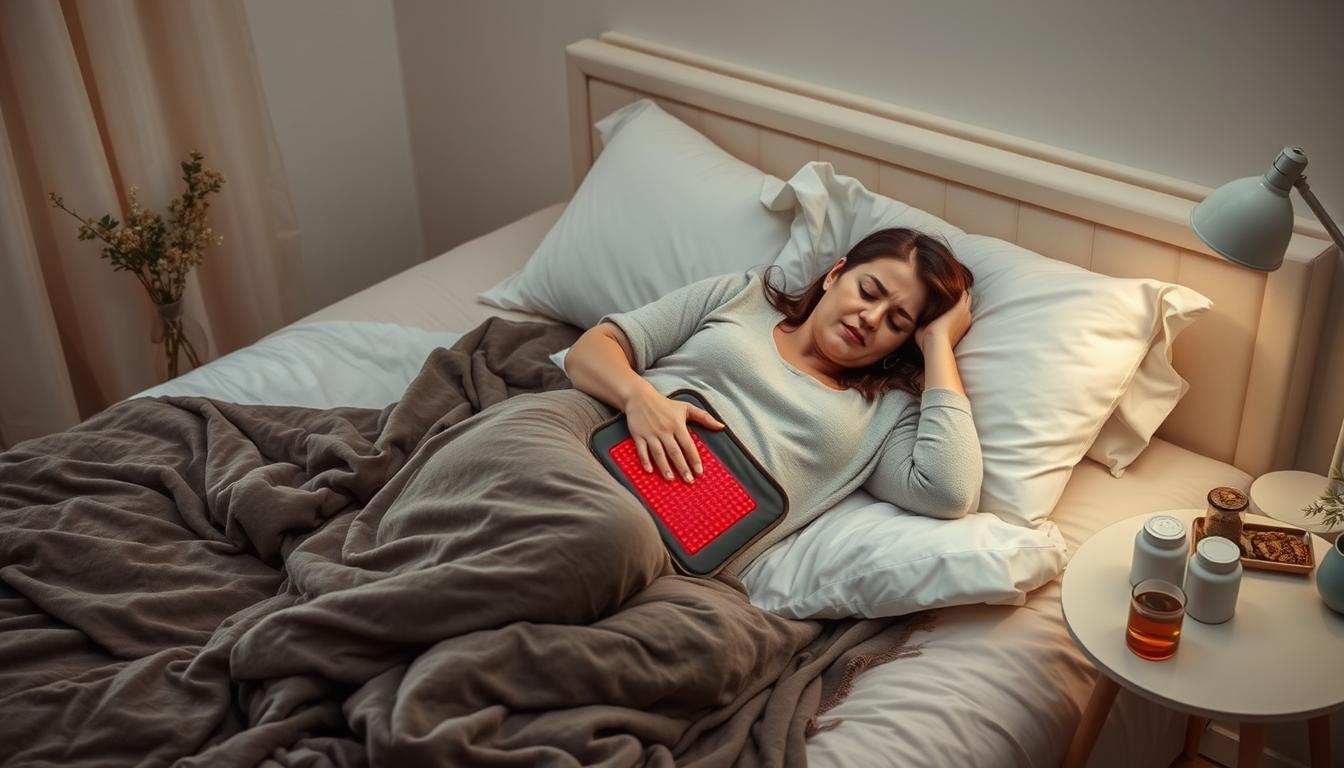Are you tired of enduring excruciating period cramps due to endometriosis? You’re not alone. Millions of women worldwide struggle with this chronic condition. It can cause debilitating menstrual pain.
But the good news is, there are effective ways to find relief. We’ll explore proven remedies, lifestyle changes, and medical treatments. These can help you say goodbye to painful period cramps for good.
Understanding Endometriosis and Its Impact
What is Endometriosis?
Endometriosis is a chronic condition where tissue like the uterine lining grows outside the uterus. This tissue grows on organs like the ovaries and fallopian tubes. It thickens, breaks down, and bleeds with each menstrual cycle, causing inflammation and scarring.
Symptoms and Effects of Endometriosis
The main symptoms of endometriosis include painful periods and heavy bleeding. It also causes pain during sex and chronic pelvic pain. Scar tissue and adhesions can make pain worse and affect fertility.
Experts say endometriosis often affects women and people AFAB between 20 and 40. It can also start in the teenage years. Risk factors include a family history, short menstrual cycles, and never having children.
Endometriosis is a major cause of infertility. The abnormal tissue can block conception. Severe cases can lead to bowel or bladder problems and pain when using the bathroom.
| Symptoms of Endometriosis | Potential Effects of Endometriosis |
|---|---|
|
|
Researchers are looking into how conditions like retrograde menstruation and immune system issues might cause endometriosis. While endometriosis itself doesn’t cause weight gain, bloating and fluid retention can make it feel like you’re gaining weight.
How to Get Rid of Painful Period Cramps
Home Remedies for Menstrual Cramp Relief
Dealing with painful period cramps can be tough. But, there are natural ways to find relief. Applying heat to the lower abdomen is one of the best home remedies. You can use a microwavable heat pad, a cordless heat wrap, or even take a warm bath. These can help relax the uterine muscles and ease the pain.
Another good option is pelvic massage. Gently massaging the lower abdomen and back can increase blood flow. This helps relax the muscles and provides relief. You can also try over-the-counter pain medications like ibuprofen or naproxen sodium. They work by targeting the inflammation that causes the cramps.
Making dietary changes can also help manage menstrual discomfort. Try to limit sodium, caffeine, and processed foods. Instead, eat more anti-inflammatory nutrients like vitamins E, B1, B6, magnesium, zinc, and omega-3 fatty acids. These can help reduce cramps.
Getting enough rest and sleep during your period is key. Stress and lack of sleep can make cramps worse. So, make sure to relax and take care of yourself.
Adding natural supplements like turmeric, cramp bark, or chasteberry to your routine may also help. These herbs and spices have been used for centuries to ease uterine cramps and alleviating menstrual discomfort.
If home remedies don’t work, try light exercise like yoga or pelvic floor exercises. These can help release endorphins and improve blood flow to the pelvic area. Remember, it’s important to listen to your body and find what works best for you when it comes to uterine cramp treatment and natural period pain relief.
| Home Remedy | How It Helps |
|---|---|
| Heat Application | Relaxes uterine muscles and increases blood flow |
| Pelvic Massage | Increases blood flow and relaxes muscles |
| Anti-inflammatory Medications | Reduces inflammation and pain |
| Dietary Changes | Reduces inflammation and cramps |
| Herbal Supplements | Provides natural relief for cramps |
| Light Exercise | Releases endorphins and improves blood flow |
Heat Therapy for Endometriosis Pain
Heat therapy can be a simple and effective way to relieve endometriosis pain. Applying heat to the lower abdomen relaxes cramped uterine muscles. This can help reduce the discomfort of this chronic condition.
Using a heating pad or hot water bottle on the lower abdomen is an easy way to start. The warmth improves blood flow, soothing the pelvic muscles. Many find 10-15 minutes of heat application can significantly ease pain during menstrual cycles or flare-ups.
Another great option is taking a warm bath. The moist heat penetrates deeper, providing more relaxation and reduced cramps. Adding lavender or chamomile essential oils can enhance the calming effects even more.
- Heating pads and hot water bottles offer convenient, on-the-go heat therapy
- Warm baths with essential oils provide deeper, more soothing heat relief
- Heat therapy helps improve blood flow and relax cramped uterine muscles
Incorporating heat therapy into your pain management routine can be a simple yet powerful step. By applying gentle warmth for a few minutes each day, you can actively manage your endometriosis symptoms.
Pelvic Massage for Alleviating Cramps
If you’re dealing with pain from endometriosis and menstrual cramps, pelvic massage might help. This gentle touch on the pelvis and lower back can greatly reduce your pain. By increasing blood flow to the pelvic area, it relaxes muscles and lessens endometriosis pain.
Benefits of Pelvic Massage
Pelvic massage has many benefits for those with menstrual cramps. It can break up scar tissue caused by endometriosis, easing your symptoms. It also increases circulation and relaxes the pelvic floor, giving you much-needed relief from pain.

There are various massage techniques, like oil massage, compression massage, and Shiatsu massage, to target specific areas. Self-massage techniques can also help ease period cramps at home.
While pelvic massage is a powerful tool for managing endometriosis pain, always talk to your healthcare provider first. They can help ensure it’s the best choice for you. With the right guidance, pelvic massage can be a key part of managing your endometriosis.
Over-the-Counter Pain Medications
If you’re dealing with painful period cramps from endometriosis, over-the-counter pain meds can help. Ibuprofen (Advil, Motrin) and naproxen (Aleve) are NSAIDs that can reduce inflammation and ease cramps.
These over the counter pain meds for period cramps block prostaglandins. These are chemicals that cause uterine contractions and pain. NSAIDs for menstrual pain are best taken when you first feel cramps, starting a day before your period.
Before taking ibuprofen for endometriosis cramps or other pain relievers, talk to your doctor. They can guide you on safe doses and side effects to keep you safe.
| Pain Medication | Dosage for Menstrual Cramps | Additional Information |
|---|---|---|
| Ibuprofen (Advil, Motrin) | 200-400 mg every 4-6 hours | May be more effective than acetaminophen for menstrual cramps |
| Naproxen (Aleve) | 220-440 mg every 8-12 hours | Longer-lasting relief than ibuprofen |
| Acetaminophen (Tylenol) | 500-1000 mg every 4-6 hours | Can be used if NSAIDs are not effective or tolerated |
Always follow the label on your medication and don’t mix pain relievers with acetaminophen. Too much can be dangerous. Always talk to your doctor for advice on managing your endometriosis-related menstrual cramps.
Dietary Changes to Manage Endometriosis Symptoms
If you have endometriosis, changing what you eat might help. Some foods can reduce inflammation and pain. More research is needed, but these changes could help.
Gluten-Free Diet and Endometriosis
Some studies show a gluten-free diet might help with endometriosis. A study with 207 women found 75% felt less pain after avoiding gluten for a year. Foods like bread and pasta should be avoided to reduce inflammation.
Also, consider a low-FODMAP diet. It cuts down on carbs that can cause digestive problems linked to endometriosis.
| Food Group | Recommended for Endometriosis | Foods to Avoid |
|---|---|---|
| Grains |
|
|
| Proteins |
|
|
| Fruits and Vegetables |
|
|
| Dairy |
|
|
| Beverages |
|
|
Everyone’s body is different, so it’s key to find what works for you. Talk to a healthcare professional or a dietitian to create a plan. They can help you manage your symptoms through diet.

Importance of Rest and Sleep
Endometriosis can be very tiring, both in body and mind. That’s why it’s key to focus on rest and good sleep to manage symptoms. Taking breaks during the day can help. Try deep breathing, a gentle walk, or calming music to reduce stress and pain.
Getting enough sleep is also vital. Not enough sleep can mess with hormone levels, increase inflammation, and make pain worse. Try to sleep 7-9 hours a night. Set up a calming bedtime routine to relax before sleep.
If sleep is hard, try to limit screen time before bed. Make your sleep area cool, dark, and quiet. Also, try yoga or meditation to relax.
By focusing on rest and sleep, you’re taking a big step to fight fatigue with endometriosis. Good rest for endometriosis helps your body and mind heal. This can lessen symptoms and improve your life quality.
Herbal Supplements for Pain Relief
If you’re dealing with endometriosis pain, herbal supplements might help. Studies show that white peony, licorice, and Sea buckthorn with St. John’s Wort may ease pain. Turmeric is also a promising option.
Turmeric: A Possible Solution?
Turmeric is known for its strong anti-inflammatory effects. It might help lessen endometriosis pain. You can take turmeric supplements or add it to your meals. It’s found in capsules, teas, and various dishes.
Remember, the FDA doesn’t check herbal supplements for quality or safety. Always talk to your doctor before trying new remedies. They can help ensure they’re right for you.
- Explore herbal supplements for endometriosis to find natural ways to manage your pain.
- Try incorporating turmeric for endometriosis pain relief into your diet or supplement routine.
- Discuss natural remedies for menstrual cramps with your doctor to find the best approach for you.
Omega-3 Fatty Acids and Their Role
If you’re dealing with painful menstrual cramps from endometriosis, omega-3 fatty acids might help. Studies show these healthy fats can cut down inflammation and ease the pain.
A study with 95 young women aged 18-22 looked at omega-3 supplements for menstrual pain. They were split into two groups. One group took omega-3 capsules daily for three months, and the other took a placebo. Both groups needed fewer ibuprofen doses, showing a pain decrease with omega-3 supplements.
The anti-inflammatory effects of omega-3s, like EPA and DHA, are thought to be why they help with pain. Another study at the Babol University of Medical Sciences in Iran found fish oil, rich in omega-3s, was better at easing menstrual pain than ibuprofen.
| Study Group | Menstrual Pain Reduction |
|---|---|
| Omega-3 Supplement Group | Significant reduction in pain levels and ibuprofen use |
| Fish Oil Group | More effective in reducing pain intensity compared to ibuprofen |
Eating more omega-3-rich foods like salmon, mackerel, and walnuts, or taking a daily supplement, could help manage endometriosis cramps. Always talk to your healthcare provider before starting any new diet or supplements.
CBD Oil: A Possible Solution?
If you have painful period cramps from endometriosis, you might wonder if cbd oil for endometriosis can help. Cannabidiol (CBD) is a part of the cannabis plant. It’s becoming popular as a natural way to handle cannabis for endometriosis pain.
Studies show that CBD might help with endometriosis pain. It could work by reducing inflammation and changing how we feel pain. This makes it a possible way to ease using cbd to manage period cramps.
You can find CBD oil in creams, ointments, and pills. But, the laws about CBD differ by state. So, it’s key to check your local laws before using it.
Talking to a doctor before trying CBD is a good idea. They can help figure out the right amount and if it will mix well with your other medicines.
Choose organic, third-party tested CBD products for safety and quality. Start with a small dose and slowly increase it. Everyone reacts differently to CBD.
Using CBD with other self-care methods like meditation, exercise, warm baths, and heat can help more. Remember, CBD isn’t a complete fix. More research is needed to fully understand its benefits for endometriosis symptoms.

If you’re thinking about trying cbd oil for endometriosis for your period cramps, be careful. Always do it with a doctor’s advice. With the right approach, using cbd to manage period cramps could offer relief.
Light Exercise for Endometriosis Management
If you have endometriosis, regular exercise can help manage your symptoms. Gentle, low-impact activities release endorphins, which are natural pain relievers. This can offer relief from endometriosis pain.
Exercise also helps with inflammation, fatigue, and brain fog. It can ease constipation and improve health and mobility. But, people with endometriosis might find it hard to stay active due to lower back issues.
Pelvic Floor Exercises and Endometriosis
Gentle exercises, like pelvic floor exercises, can improve physical function. They may also reduce endometriosis-related pain. These exercises target muscles that support the pelvic organs.
A 2017 study showed hatha yoga can reduce pelvic pain in endometriosis patients. Yoga styles like Hatha, yin, and restorative are good for managing symptoms. They offer relief through gentle movements.
Before starting any exercise, talk to your healthcare provider. They can suggest the best activities for you. They’ll help create a plan that fits your needs and symptoms.
Managing endometriosis involves many steps, and exercise is a key part. Gentle exercises can be a valuable part of your treatment. By focusing on your physical and emotional health, you can actively manage this chronic condition.
Medical Treatments for Endometriosis
Some people with endometriosis need medical help to feel better. Doctors might suggest hormone therapy or surgery. They might also prescribe pain meds like NSAIDs. The right treatment depends on how bad the endometriosis is and what the person wants.
Hormone Therapy for Endometriosis
- More than 80% of women with severe pain from endometriosis see their pain lessen with GnRH analogues.
- Hormone birth control can stop heavy bleeding often seen with endometriosis. Taking it for three months or more can also stop periods.
- Some hormone therapies, like GnRH analogues, can make a woman’s body think it’s in menopause because they lower estrogen.
- Danazol, a drug for endometriosis, stops hormones that start menstruation. It should be used with birth control to avoid pregnancy.
- Aromatase inhibitors are sometimes used off-label for endometriosis pain, but only if pregnancy isn’t a concern.
Surgical Treatments for Endometriosis
- Endometriosis can be treated with surgery, often laparoscopy to remove affected tissue.
- Surgery, like laparoscopy, can help with pain from endometriosis.
- Surgery can confirm endometriosis and cure it in up to 70% of women.
- Removing the uterus and endometriosis can cure it in over 90% of women, but makes it impossible to get pregnant.
Choosing a treatment for endometriosis depends on what the person needs and wants. It’s important to talk to a doctor to find the best option.
| Treatment | Effectiveness | Considerations |
|---|---|---|
| Hormone Therapy | Over 80% pain reduction with GnRH analogues | Can cause temporary menopause, may affect pregnancy |
| Surgical Treatments | Improves pain symptoms, up to 70% long-term cure | Provides diagnosis, but may remove fertility |

Foods to Avoid for Endometriosis Relief
If you have endometriosis, your diet is key to managing symptoms. Some foods can trigger inflammation and make your condition worse. It’s important to know and limit these endometriosis trigger foods.
A 2013 study found that red meat, trans fats, and caffeine can make endometriosis symptoms worse. A 2015 review also showed that eating more fruits, vegetables, whole grains, and omega-3 fatty acids can help prevent endometriosis.
Here are some foods to avoid with endometriosis:
- Gluten: A gluten-free diet can reduce pain and symptoms in up to 75% of women with endometriosis.
- Dairy products: Dairy can cause inflammation and make endometriosis symptoms worse.
- Red meat: Eating red meat can increase inflammation and worsen endometriosis symptoms.
- Processed foods: Foods high in fat and sugar can promote inflammation and should be limited.
- Caffeine and alcohol: These can disrupt hormone balance and worsen endometriosis symptoms.
- Soy products: Soy contains phytoestrogens that can mimic estrogen and make endometriosis worse.
Keeping a food diary can help you find out which endometriosis trigger foods are bad for you. By avoiding these foods, you might find relief from endometriosis pain.
Changing your diet is just one part of managing endometriosis. Regular exercise, managing stress, and getting medical help are also important. While there’s no cure, a holistic approach can help you control your symptoms and improve your life.
Causes and Risk Factors of Endometriosis
Endometriosis is a complex condition that doctors don’t fully understand. They think a mix of factors might cause it. This makes it a chronic and painful disorder.
Immune system issues might play a part in endometriosis. The body might attack its own tissue wrongly. Also, when menstrual blood flows back into the pelvis, it could spread endometrial tissue.
Genetics and hormonal imbalances might also contribute. Research shows that having a close family member with the condition can increase the risk of developing endometriosis. Early menstruation and never having given birth might also increase the risk.
Symptoms of endometriosis vary a lot. Some people have severe pain, while others might not know they have it. Endometriosis can really affect someone’s life, making it hard to work, go to school, or have sex.
Understanding endometriosis is key to helping those affected. By knowing what might cause it, doctors can find better ways to prevent and treat it. This could help people with endometriosis manage their symptoms and feel better overall.
Diagnosing Endometriosis: From Symptoms to Laparoscopy
If you’re feeling persistent pelvic pain, heavy or irregular periods, or pain during sex, talk to a healthcare provider. They will start with a physical exam and ask about your health history. This is the first step in diagnosing endometriosis.
They might use imaging tests like ultrasound or MRI to look for endometrial growths. But the best way to confirm endometriosis is through a laparoscopy. This surgery uses a tiny camera to check the pelvic area and take a biopsy. This helps make a sure diagnosis and sometimes treats the condition.
Laparoscopy is the top choice for diagnosing endometriosis. It lets the surgeon see endometrial cells or lesions in the pelvic cavity. This method is great for women who have been waiting for a diagnosis. It’s also useful for those who have infertility instead of pain symptoms.
Source Links
- https://www.medicalnewstoday.com/articles/321402
- https://www.webmd.com/women/endometriosis/ss/slideshow-unexpected-ways-to-ease-endometriosis-pain
- https://my.clevelandclinic.org/health/diseases/10857-endometriosis
- https://www.mayoclinic.org/diseases-conditions/endometriosis/diagnosis-treatment/drc-20354661
- https://www.webmd.com/women/ss/slideshow-get-rid-of-cramps
- https://www.nhs.uk/conditions/period-pain/
- https://www.houstonmethodist.org/blog/articles/2021/sep/menstrual-cramps-5-tips-for-getting-relief-from-period-pain/
- https://www.healthline.com/health/womens-health/endometriosis-pain-relief
- https://www.hopkinsmedicine.org/health/wellness-and-prevention/period-pain-could-it-be-endometriosis
- https://www.healthpartners.com/blog/13-ways-to-stop-period-pain/
- https://pressmodernmassage.com/blogs/going-deep/massage-for-period-cramps
- https://www.mayoclinic.org/diseases-conditions/menstrual-cramps/diagnosis-treatment/drc-20374944
- https://www.healthline.com/health/womens-health/menstrual-cramp-remedies
- https://myhealth.alberta.ca/Health/aftercareinformation/pages/conditions.aspx?hwid=uf7084
- https://www.healthline.com/health/endometriosis/endometriosis-diet
- https://health.clevelandclinic.org/endometriosis-diet
- https://www.webmd.com/women/endometriosis/ss/slideshow-endometriosis-lifestyle-changes
- https://www.medicalnewstoday.com/articles/sleeping-positions-for-menstrual-cramps
- https://www.medicalnewstoday.com/articles/how-to-stop-period-pain-forever
- https://www.health.com/condition/menstruation/menstrual-pain-natural-remedies
- https://www.gaiaherbs.com/blogs/seeds-of-knowledge/natural-solutions-menstrual-cramps?srsltid=AfmBOorwQ4IJhCFnY-NC48Gjb_KFQu7EGAp41X9sMJwVKqoBx5pHv3kl
- https://vivaeve.com/menstrual-pain-relief-may-be-found-in-omega-3s/
- https://www.ncbi.nlm.nih.gov/pmc/articles/PMC3770499/
- https://www.medicalnewstoday.com/articles/cbd-for-menstrual-cramps
- https://vediherbals.com/blogs/blog/cannabis-for-period-cramps-how-cbd-can-help-ease-your-menstrual-pain?srsltid=AfmBOopZvqpwUA6lPgKqOci-rvCTAanIcm_hQO7Z-j61jD8ug0U4QEMc
- https://www.healthline.com/health/endometriosis/endometriosis-and-exercise
- https://www.medicalnewstoday.com/articles/endometriosis-exercise
- https://www.healthline.com/health/fitness/yoga-for-endometriosis
- https://www.webmd.com/women/endometriosis/understanding-endometriosis-treatment
- https://www.thewomens.org.au/health-information/periods/endometriosis/treating-endometriosis
- https://www.medicalnewstoday.com/articles/321471
- https://www.health.com/condition/endometriosis/endometriosis-diet
- https://healthmatters.nyp.org/what-to-eat-during-your-period-foods-that-help-reduce-cramps-and-foods-to-avoid/
- https://www.hopkinsmedicine.org/health/conditions-and-diseases/endometriosis
- https://www.who.int/news-room/fact-sheets/detail/endometriosis
- https://www.brighamandwomens.org/obgyn/infertility-reproductive-surgery/endometriosis/endometriosis-symptoms
- https://www.aafp.org/pubs/afp/issues/1999/1015/p1753.html
- https://www.jeanhailes.org.au/health-a-z/endometriosis/diagnosis
